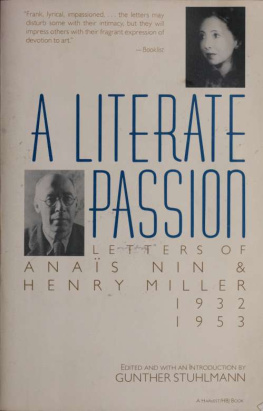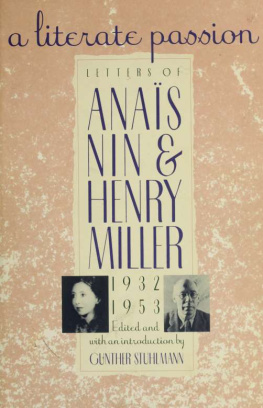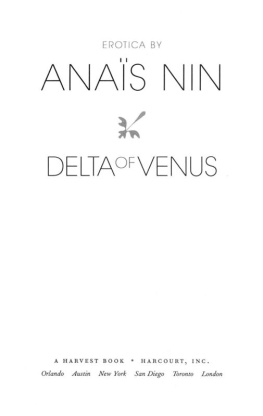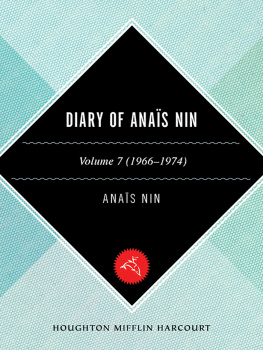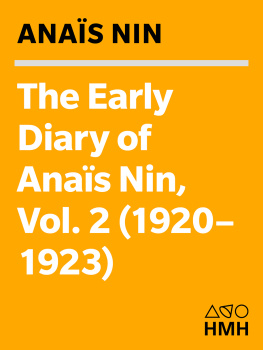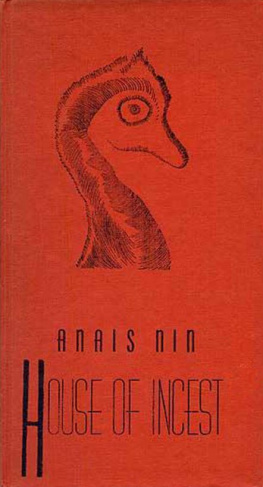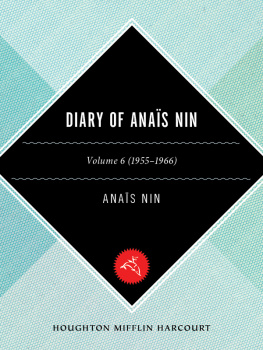A Harvest/HBJ Book
Harcourt Brace Jovanovich
New York and London
Copyright 1971 by Anais Nin
Preface copyright 1971 by Gunther Stuhlmann
All rights reserved.
No part of this publication may be
reproduced or transmitted in any form or by
any means, electronic or mechanical,
including photocopy, recording,
or any information storage and
retrieval system, without permission in
writing from the publisher.
Requests for permission to make copies of any part of the
work should be mailed to: Copyrights and Permissions Department,
Harcourt Brace Jovanovich, Publishers, Orlando, Florida 32887.
Library of Congress
Catalog Card Number: 66-12917
ISBN 0-15-626028-x
Printed in the United States of America
I J K L M
Preface
The publication, during the past five years, of three volumes drawn from the monumental Diary of Anas Nin, which she has kept now for half a century, has brought to the author a cornucopia of critical acclaim. It has established Miss Nin's life work, in the words of one critic, as "one of the most remarkable diaries in the history of letters."
This intensely personal document also seems to have assumed a special individual significance for many contemporary readers, which goes beyond the genuine literary, historical, and biographical value of the Diary. Transcending the borders of age and background, its spectrum of recorded experience, thought, and emotion seems to invite direct identification, a sense of recognition, a sharing of concerns. In the numerous personal letters addressed to Miss Nin one note is struck again and again: "Yes, this is exactly the way I have felt, myself; these are the very things I am struggling with now." Many readers, especially among the young, have responded to the Diary with an intensity, an open directness, reminiscent of the voluble emotions released by Miss Nin almost four decades ago in the "Hotel Chaotica" in New York. Indeed, this very personal response to the Diary seems to bear out Miss Nin's assumptionquoted in the preface to Volume IIthat "the personal life deeply lived always expands into truths beyond itself."
The specifics, the special circumstances of Miss Nin's own exploration of the "inner spaces" of the self, lucidly presented, sharply observed, open themselves to sharing: her uncertain childhood as a European "exile" in New York; the long struggle to free herself from the domineering shadow of her father; the lifelong effort to create for herself and her friends a nourishing, "livable" environment in a troubled, hostile, or indifferent world; her attempts to gain a totality of experience, a "personal relation to all things and people"; and her constant striving to capture an intuitive rather than ideological "feminine consciousness" in both her life and her art. The personal, the singular, expands under the prism of the Diary to become, in Miss Nin's words, "universal, mythical, symbolic." ("The hero of this book," she notes in these pages, "is the malady which makes our lives a drama of compulsion instead of freedom.")
The preceding three volumes, extracted from the broad flow of the original Diary manuscripts, are essentially self-contained units. Each forms, as it were, a complete "chapter" in the "book" of Anais Nin's life. Each volume marks a stage in Miss Nin's development. Each moves from a particular starting point toward change, greater awareness, new beginnings. At the core of each volume is exploration, unfolding, growth.
Volume I opened in Louvecicnnes, near Paris, when, in 193, Miss Nin first appeared in print with a deeply felt appreciation of D. H. Lawrence, who had been quietly buried in Vence only a year earlier. This publicationthrough a chain of circumstances pinpointed only by hindsightled to her contact with the unknown expatriate Henry Miller, to the "mad" Antonin Artaud, to psychoanalysts Dr. Ren Allendy and Dr. Otto Rank, to her own discovery of the turmoils and possibilities of psychoanalysis. Volume II (1934-1939) saw Miss Nin in New York, caught between the demands of analysis and her need to write, opting for the latter, returning to her "romantic life" in France only to be forced, by the outbreak of World War II, to leave again, to part from a pattern of life she knew she "would never see again." Volume III (1939-1914) mirrored her second "exile" in New Yorkparalleling, emotionally, much of her childhood experience (which gave the initial impetus to the Diary itself) as a reluctant refugee in Manhattanand her efforts to establish herself as a "foreign" writer on these shores.
The present volume continues the chronology. It links up with her first "breakthrough" here as a writer, early in 1944, following the publication of a handset edition of her stories, Under a GlassBell, and a review by Edmund Wilson in the New Yorker. It is based on the original manuscript volumes sixty-eight to seventy-four. Miss Nin and the editor have followed the same principles of selection established in the previous volumes. The bracketed dates have been supplied by the editor. The omission of some characters was again necessary, and a few names have been changed and are indicated as pseudonyms in the index.
The basic themes of the Diaryself, femininity, neurosis, freedom, relationships, the confluence of art and lifealso provide the essential strands in the tapestry of this volume. Again, there is often a "prophetic" quality to Miss Nin's endeavors and responses. Her antennae detect and register, as the radar of true artists has done through the centuries, much that was only dimly perceived at the time. Much of what she felt and sensed about vital aspects of life in America during the 1940s foreshadowed, in its implications, many of the strong concerns voiced only recently on a larger scale by the revolutionary young, by the advocates of a "new consciousness."
In this country, among the people who fielded the giant armada that defeated Hitler's Germany, that atom-blasted Japan into surrender, she perceived, amidst all the power and technology, a curious emptiness. "The drama of our present life," she writes, is that there is "nothing big enough, deep enough, strong enough." America's most active contribution to the formation of character, she notes, is the development of an impermeable shell behind which to hide. "A tough hide. Grow it early."
Most of the men she meets are "plain, one-dimensional." She deplores their single-mindedness, their lack of color. They are "prosaic down-to-earth, always talking of politics, never for one moment in the world of music and pleasure, never free of the weight of the daily problems, never joyous, never elated, made of either concrete and steel or like workhorses, indifferent to their bodies, obsessed with power."
She misses meaningful personal relationships. "Every friend I reach out here to seems incapable of big friendship." The depersonalization of relationships alarms her. "My friendships, instead of being concentrated on a very few, as in Paris, have become fragmented into many. I find only partial relationships."
"I am aware," she writes, "that what I love and seek is illusive, tricky.... What ought to be and not what is interests me....In between, an all-consuming loneliness."
Miss Nin's continuing refuge still is the world of the young, the undiscovered, the potential realizers of "what ought to be." "When I am with mature people," she confesses, "I feel their rigidities, their tight crystallizations." She is tossed back, emotionally, into the strictured atmosphere of the Spanish father. "With the young," on the contrary, "one lives in the future. I prefer that." Perhaps by identifying with the young ("I feel as they do, I think and act as they do"), by being "open," and not yet "finite," she herself can escape finality, she can stay fluid, mercurial.
Next page

